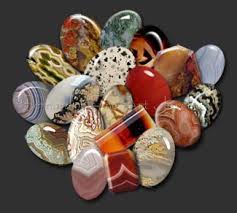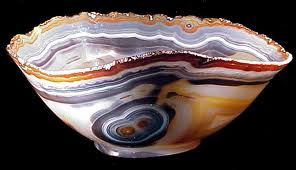Departments
Search
Follow Us
Tags
Latest Highlights
IBH
Chalcedony (Quartz part two)
 Posted by Rasmussen Gems and Jewelry LLC
Posted by Rasmussen Gems and Jewelry LLC
Chalcedony is a catch all term that includes many well known varieties of cryptocrystalline quartz gemstones. They are found in all 50 States, in many colors and color combinations, and in sedimentary, igneous, and metamorphic rocks. Chalcedony includes carnelian, sard, plasma, prase, bloodstone, onyx, sardonyx, chrysoprase, thundereggs, agate, flint, chert, jasper, petrified wood, and petrified dinosaur bone just to name a few of the better known varieties.
Flint, chert and onyx are usually found in black. The absence of all color.
Carnelian and jasper tend to be red in color.
Bloodstone is green with red dots; whereas prase and chrysoprase are usually green.
Thundereggs (geodes), agate, petrified wood and petrified bone are usually banded.
 All of these being a form of quartz, have the same general characteristics. Chalcedony is usually opaque to translucent, so are usually cut en cabochon. Various locations and patterns give rise to many names for different agates. However, the stone is still chemically and physically silicon dioxide. Debating the adjective ahead of the word agate is a useless, pointless discussion. Agates are easily cut, and can make some of the most beautiful cabochons used in jewelry.
All of these being a form of quartz, have the same general characteristics. Chalcedony is usually opaque to translucent, so are usually cut en cabochon. Various locations and patterns give rise to many names for different agates. However, the stone is still chemically and physically silicon dioxide. Debating the adjective ahead of the word agate is a useless, pointless discussion. Agates are easily cut, and can make some of the most beautiful cabochons used in jewelry.
 Because of its abundance, durability, and beauty, chalcedony was, except for sticks, animal skins, bones, plain rocks, and possibly obsidian, the earliest raw material used by humankind. The earliest recorded use of chalcedony was for projectile points, knives, tools, and containers such as cups and bowls. Early man made weapons and tools from many varieties of chalcedony including agate, agatized coral, flint, jasper, and petrified wood. Here is a bowl carved from a large piece of agate.
Because of its abundance, durability, and beauty, chalcedony was, except for sticks, animal skins, bones, plain rocks, and possibly obsidian, the earliest raw material used by humankind. The earliest recorded use of chalcedony was for projectile points, knives, tools, and containers such as cups and bowls. Early man made weapons and tools from many varieties of chalcedony including agate, agatized coral, flint, jasper, and petrified wood. Here is a bowl carved from a large piece of agate.
Posted by Rasmussen Gems and Jewelry LLC
Tags: agate, carved agate, chalcedony, gemstones, handamade artists, Handmade, handmade agate
Posted in Information
2 Responses to “Chalcedony (Quartz part two)”
Leave a Reply
You must be logged in to post a comment.


Great info John! Thanks for sharing 😀
Thank John… the cabochon to the right is AMAZING! It looks like a riverbank with a mountain in the distance background. Beautiful!
I know you have to cut and shape the stones, but do you see a pattern before you cut, as you are cutting (or shaping)? Wow, what was my question? … lol